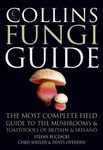The second edition of this standard work has about six percent more pages and some more illustrations than the first one. A few illustrations have been replaced, the few typographical errors corrected and the nomenclature of treated fungi updated (e.g. Coprinellus, Coprinopsis, Contumyces). The structure corresponds to the previous edition. The text was revised in places and new findings of the last decade were incorporated. Fundamental aspects of cytology, plectology ("histology") and anatomy of Agaricomycetidae (formerly Hymenomycetes), e.g. Agaricales, Boletales, Polyporales, Cantharellales and others are discussed. Heinz Clemençon presents knowledge of mycological research from the late 18th Century until spring of 2011. The focus is on the description of the mushroom anatomy under critical examination of the relevant aspects. The author puts special emphasis on the terminology used, which he updated and checked for logical errors. Terms to be avoided and rejected are listed. Although the terminology certainly is not yet used as widespread as hoped by the author, it is very valuable to find the concepts so clearly presented and summed up. The respective structures are richly illustrated with black/white photos of excellent thin sections. To illustrate the many photographs schemata are included. Remarks on the historical development precede almost every chapter.
Perfect complements are two more books by the same author: one with many coloured illustrations of the anatomical thin sections (Clemençon, H., 2012: Großpilze im Mikroskop. Beiheft zur Zeitschrift für Mykologie 12) and a methodological book (Clemençon, H.: Methods for working with macrofungi: laboratory cultivation and preparation of larger fungi for light microscopy). The main chapters deal with:
1st. Basic concepts.
2nd. The hyphae of the Hymenomycetes (cytology of vegetative hyphae, hyphal walls, septa, dolipores, cytoplasm, nucleus, mitosis, clamp connections, hyphal types and their correct name).
3rd. The mycelium and its organs (mycelial types and organization, specific cell types such as allocysts, stephanocysts, mycelial cystidia and basidia, rhizomorphs).
4th. Mitospores of the Hymenomycetes (conidia, chlamydospores, hyphal fragments).
5th. Basidia and basidiospores (terminology, sporulation, karyology and meiosis, types of basidia, structure of basidiospores like wall, germ pore, spore discharge).
6th. Cystidia, pseudocystidia and hyphidia (terminology and types, such as lampro-, lageno-, skeletocystidia).
7th. Pigment topography.
8th. Bulbils, sclerotia and pseudosclerotia.
9th. Basidiomes (fruit body types, hymenophore and hymenium, plectology of the fruiting bodies, pseudorhizae, Rhacophyllus-forms, stilboids).
10th. Carpogenesis: terminology and types of fruiting body development using many examples.
11th. Associations of Hymenomycetes with other organisms (bacteria, Cyanoprokaryota, algae, mosses, mycorrhiza, this is covered only briefly, termites, ants).
A detailed table of contents, a comprehensive bibliography, taxonomic and subject index allow quick orientation in the book.
Actually, the positive reviews of the first English edition, e.g. in Mycol. Res, Persoonia, inoculum and in the Austrian Journal of Mycology, available on the homepage of the publisher (www.schweizerbart.de/publications/detail/isbn/9783443591014/), can be adopted unchanged for the second edition. The work is a treasure trove of information about basic understanding of anatomy and morphology of fungi. Everyone working in mycology will find suggestions and further information. I do not doubt that the second edition will be an indispensable reference for all who have to do with microscopic features of hymenial cell biology, anatomy, ontogeny or taxonomy. Also I can recommend reading for deeply interested amateur mycologists."
- Irmgard Krisai-Greilhuber, Sydowia 164(2)
















![Die Gattung Hyphodontia John Eriksson [The Genus Hyphodontia John Eriksson]](http://mediacdn.nhbs.com/jackets/jackets_resizer_medium/59/59441.jpg?height=150&width=93)


























